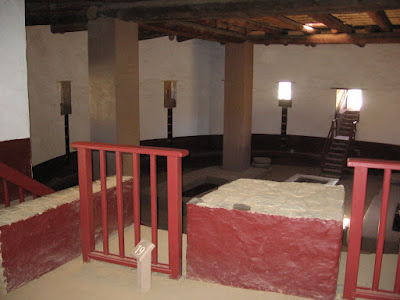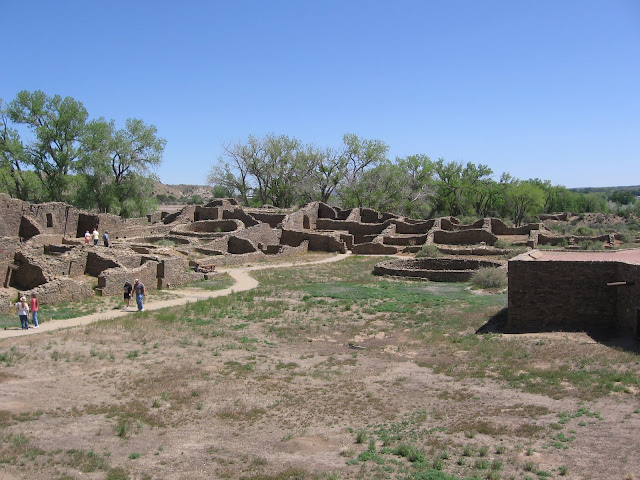 The Great Kiva at Aztec Ruins in northwest New Mexico is the only reconstructed Great Kiva of the dozens in the southwest. It was reconstructed in 1934 based on the remnants of the original building.
The Great Kiva at Aztec Ruins in northwest New Mexico is the only reconstructed Great Kiva of the dozens in the southwest. It was reconstructed in 1934 based on the remnants of the original building. Entering the Great Kiva is something like entering a church. The kivas were thought to be used for religious purposes and were constructed down into the earth, entering the realm of the spirits. "Show respect" the interpretive signs remind visitors.
Entering the Great Kiva is something like entering a church. The kivas were thought to be used for religious purposes and were constructed down into the earth, entering the realm of the spirits. "Show respect" the interpretive signs remind visitors. The inside is nicely plastered and painted in red and white. It is easily forgotten that most walls at these ruin sites were plastered and decorated. Now, we mostly just see the raw stone work, weathered for 700 years.
The inside is nicely plastered and painted in red and white. It is easily forgotten that most walls at these ruin sites were plastered and decorated. Now, we mostly just see the raw stone work, weathered for 700 years.Around the perimeter are 15 rooms with ladders and small doors. These small rooms had doors out onto the plaza also. It is not known what these rooms were for. The large beams in the roof would have had to been brought from many miles away as the immediate environment around Aztec Ruins doesn't support large trees.
 Four large columns support the 95 ton roof. The foundation for the columns were four limestone disks, which had to have been carried from at least 40 miles away. The feeling I got from the interior was like it was a nice reception area for an upscale resort.
Four large columns support the 95 ton roof. The foundation for the columns were four limestone disks, which had to have been carried from at least 40 miles away. The feeling I got from the interior was like it was a nice reception area for an upscale resort. From the exterior you can gaze in through the door of one of the 15 surrounding small rooms. The interpretive literature at these southwestern ruins sites doesn't mention where visitors and travelers stayed. That's how the Great Kiva's outer rooms struck me, as a nice place for visitors.
From the exterior you can gaze in through the door of one of the 15 surrounding small rooms. The interpretive literature at these southwestern ruins sites doesn't mention where visitors and travelers stayed. That's how the Great Kiva's outer rooms struck me, as a nice place for visitors. The West Ruins has been excavated and is a massive structure of about 400 rooms with three stories, with very thick walls. There is an equally large East Ruins that remains unexcavated and is not open to the public except on special tours. The trail that winds around the West Ruins is short, about 700 yards, but there is a lot to see.
The West Ruins has been excavated and is a massive structure of about 400 rooms with three stories, with very thick walls. There is an equally large East Ruins that remains unexcavated and is not open to the public except on special tours. The trail that winds around the West Ruins is short, about 700 yards, but there is a lot to see.


